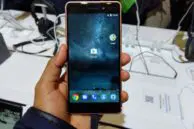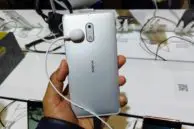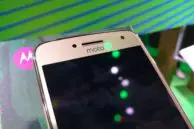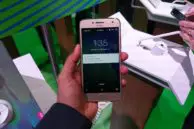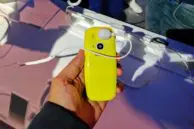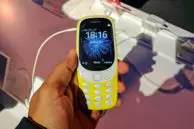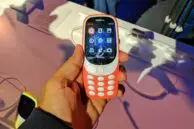
The most major mobile launches during the first quarter of a year are done at MWC. This year’s MWC was no different, with Samsung being the only notable company that did not announce its new flagship at the event.
Nonetheless, while there was no Galaxy S8 at MWC this year, there were still plenty of other phones launched by BlackBerry, LG, and Nokia to catch your attention. If you were overwhelmed by the barrage of phone and tech announcements in the last few days and missed out on the phones that are actually worth a look, check out our roundup of the 5 hottest smartphones at MWC 2017 below.
LG G6

LG was the first company to launch its flagship Android smartphone at MWC. After the disastrous G5 last year, LG has come out with a beautiful looking phone with the G6 this year. The glass design and metal chassis give the handset a very premium look and feel with the IP68 certification being an added bonus. Even better, the almost bezel-less display at the front gives the G6 a very futuristic look. The G6 also kickstarts the trend of phones launching with almost no bezels at the front. This makes the G6 very compact as well; despite coming with a 5.7-inch 18:9 aspect ratio display, the LG G6 is smaller than the likes of Google Pixel and iPhone 7 Plus.

The rest of the specs of the LG G6 are pretty decent as well, though by no means are they in line with a flagship phone of 2017. We are looking at a Snapdragon 821 chipset clocked at 2.4GHz, dual-13MP camera setup at the rear, 5MP selfie shooter, 3200mAh battery, 4GB RAM, 32/64GB storage, microSD card slot, and a quad-DAC (albeit not in the US).
Read: LG G6 Hands On
Nokia 6 (+3 & 5)
Nokia launched not one, but three new Android smartphones at MWC 2017: the Nokia 3, Nokia 5, and Nokia 6. All the three phones are your run-of-the-mill mid-range Android smartphones but with some nice touches that make them better than other phones in their respective price range. Nokia and HMD Global have ensured that all the three phones run on the purest form of Android available. Additionally, the three handsets will also receive quick Android updates, with HMD Global even committing to regular security updates. No other Android OEM has committed to offering monthly security updates for their mid-range devices, so if HMD Global manages to pull ths off, it would definitely give the company an edge over its competition.
When looked purely from a specs viewpoint, the Nokia 3, 5, and 6 are not going to win any race. But all the three handsets feature a very premium build quality that other phones in the same price band despite featuring a metal body lack.
Moto G5 Plus
Not many people were interested in the Moto G5 Plus at the MWC show floor. However, it is one of the most impressive handsets to launch at the trade show this year. The handset is not going to win any design accolades with the hefty bezels at the top and bottom. But at least this time around, Motorola ensured that its G5 series features a metal body.
When compared to other mid-range phones in the market, the Moto G5 Plus packs specs that are on par for the course: a Snapdragon 625 chipset, 3/4GB RAM, 32GB storage, and a 3000mAh battery. What sets this device apart from the competition is its 12MP shooter at the rear. Featuring large 1.7um pixels and Dual AF pixels, the G5 Plus on paper sports the same camera setup as the Galaxy S7 edge (barring OIS). For a handset that will cost $229, this is very impressive. The camera setup might not be able to rival the Galaxy S7 edge in terms of image quality but be rest assured that it should still be head and shoulders above other mid-range devices.
Nokia 3310

The least feature-packed phone announced at MWC, but the one that stole the spotlight. The re-launch of Nokia has garnered crazy attention from the press and consumers alike. While Nokia also announced three smartphones running Android, it is the Nokia 3310 that has managed to catch everyone’s attention.
The original Nokia 3310 was known for its battery life and indestructible build quality. It’s tough to say whether the new Nokia 3310 will be able to live up to those claims, but for a feature phone, this is still a fine handset by all means. Packing in a 2.2-inch display, a 2MP rear shooter with a LED flash, and a staggering 30-day of standby battery life, the Nokia 3310 was perhaps the only device launched at MWC to only feature 2.5G connectivity.
Launching in Q2 this year, it will be interesting to see if the handset once again manages to sell like hot cakes like its predecessor did. Or if people were only interested in checking out the handset at the MWC show floor just for pure nostalgia.
Sony Xperia XZs and XZ Premium
Sony also launched its 2017 Xperia lineup at MWC, with the Xperia XZs and XZ Premium being the most interesting of the bunch. The phones are a minor upgrade over their predecessor, with the most interesting aspect about them being their new 19MP camera sensor at the rear. Thanks to a stacked DRAM, the 19MP shooter on the Xperia XZs and XZ Premium is able to record videos at 960fps slow-motion in 720p resolution.

The Xperia XZ Premium also stands out for its mirror-like finish. The handset essentially acts like a mirror, which might seem nice at first but does make it a fingerprint magnet. It was also the only phone announced at MWC this year with a Snapdragon 835 chipset. However, the phone will not go on sale until May or June this year by which point other Snapdragon 835-powered devices would have already hit the market.
Huawei P10 and P10 Plus

Huawei launched its latest flagship for Europe at MWC: the P10 and P10 Plus. The phones look largely similar to their predecessor, but now come in a multitude of colors and finish. In terms of specs, the P10 and P10 Plus are similar to Huawei’s Mate 9 with a Kirin 960 chipset, 4/6GB RAM, 3250/3750mAh batteries, and dual Leica camera setup. The P10 Plus does sport a better iteration of Leica’s camera setup with its 12/20MP rear shooters featuring a f/1.8 aperture.
When you compare the P10 and P10 Plus to other smartphones that launched in MWC though, they feel boring. While the new color options are nice, the handsets don’t really bring anything radically new to the table. Huawei might be among the fastest growing smartphone OEMs out there, but its growth has been primarily limited to China. If the company needs to win customers in the US and Europe, it needs to do better than the P10/P10 Plus.

Honourable Mention – BlackBerry KEYone

The BlackBerry KEYone gets an honourable mention in this list purely because of what TCL/BlackBerry are trying to achieve with it. After the Priv, the KEYone is only the second Android handset to launch in the last few years to feature a physical keyboard. While the Priv had a slide-out keyboard, the KEYone has a candy bar design which means the keyboard sits right below the display.
This does lead to the KEYone coming with a small 4.5-inch screen, but with capacitive buttons and a physical keyboard, you are getting the whole display for viewing content. Barring its form factor, the KEYone is a mid-range Android phone that features a camera setup similar to that of the Google Pixel. You can read more about the BlackBerry KEYone here.

Which phone unveiled at MWC are you looking forward to the most on getting your hands on? Or were you bummed about Samsung not launching the Galaxy S8 at MWC this year?
